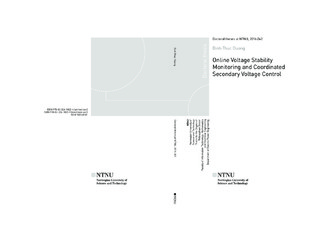| dc.description.abstract | The development towards increasing use of renewable energy sources and smart grid
applications represent a paradigm shift in power system operation. Due to the large share
of variable generation and more dynamic load patterns, operation conditions in the future
grid will change faster than today’s situation. This will render the grid less predictable and
consequently affect system operation, and voltage stability will undoubtedly remain one
of the major concerns. In this scenario, it is necessary to have new real-time monitoring
tools to timely identify operational limits in order to devise preventive and corrective
schemes to maintain security of operation.
Aiming at developing new online monitoring tools for power systems, the PhD project
has produced two methods to assess voltage stability in real time. Both are based on estimation
of the Thevenin impedance and consequently the maximum power transfer. The
first one estimates the Thevenin impedance by only local phasor measurements; meanwhile,
the second approach obtains the Thevenin impedance by combination of system
topology and measurements from phasor measurement units (PMUs). Although the second
method takes the system topology into its calculation, it requires only information
of the studied area, which is quite small since it is limited by boundary nodes. Therefore,
both proposed methods are suitable for online implementation. Through simulations
of the dynamic model of the Norwegian transmission system, the two algorithms result
in comparable estimations of the Thevenin impedance, and both successfully detect the
margin to voltage instability. In addition, with the topology-based method, it is able to
estimate the post-contingency Thevenin impedance in real time. Thanks to this capability,
it is possible to issue early warning of impact of critical disturbances on voltage
stability, which is vital for the secure and reliable operation of power systems.
Apart from the estimation of the Thevenin impedance, the PhD work also introduces a
new indicator called S-Z sensitivity indicator (S-ZI) for online voltage stability monitoring.
The algorithm for the new indicator is simple and requires only PMU measurements of
voltage and current of the considered load. Since the S-ZI is computed directly from the
local phasor measurements, the method works robustly; it does not face any problems
with divergence as often experienced in other approaches. The proposed indicator also
shows a good performance in detecting the margin to the voltage stability limit, with both
simulation and real PMU data. In addition, the S-ZI also functions as a calibrating tool to
verify accuracy of the online estimated Thevenin impedance. Based on this new indicator
and the proposed algorithm for estimation of the Thevenin impedance, a prototype of
online voltage stability monitoring has been built and tested with live stream of PMU
data obtained from the Norwegian transmission system. The results from the tests at two
locations in the 420kV and 130kV networks have shown that the proposed methods have
performed very well with real measurements in power systems.
Additionally, a scheme for coordinated secondary voltage control for systems with multiple VAr reserves has been introduced in the PhD project. The proposed scheme is
inspired by the concept of multi-agent system. Like an agent, the local controller takes on
the assigned tasks itself and contacts its neighbors for support when needed. The control
structure incorporates not only controllable VAr sources but also mechanically switched
capacitor banks and reactors, resulting in increased online reactive power reserves for
critical contingencies. The approach is suitable for areas with high penetration of FACTS
devices, distributed generation connected to power systems through voltage source converters
(VSCs), or VSC-HVDC systems. Moreover, the proposed scheme is also simple
and flexible in terms of coordination, implementation and expansion. Through simulations,
the control scheme has shown a good performance in coordinating reactive power
sources to obtain a flat voltage profile and sufficient reactive power reserves, not only in
normal operation but also under disturbance conditions. | nb_NO |
